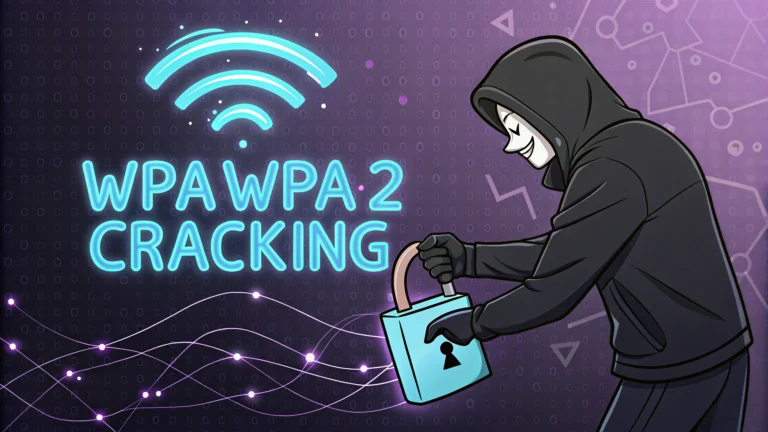WPA/WPA2 cracking is a key skill for penetration testers to assess wireless network security and identify vulnerabilities before malicious actors can exploit them.
Understanding WPA/WPA2
WPA (Wi-Fi Protected Access) and its successor WPA2 are security protocols designed to protect wireless networks from unauthorized access.
Common Attack Methods
- Dictionary Attacks
- Brute Force Attempts
- WPS PIN Exploitation
- PMKID-based Attacks
- Evil Twin Attacks
Required Tools
These essential tools enable successful WPA/WPA2 security testing:
- Aircrack-ng Suite
- Wireless Network Adapter (Supporting Monitor Mode)
- Hashcat
- John the Ripper
- Wireshark
Testing Process
- Network Reconnaissance
- Enable monitor mode:
airmon-ng start wlan0 - Scan networks:
airodump-ng wlan0mon
- Enable monitor mode:
- Capture Handshake
- Target specific network:
airodump-ng -c [channel] --bssid [MAC] -w [filename] wlan0mon - Deauthenticate client:
aireplay-ng --deauth 5 -a [router MAC] -c [client MAC] wlan0mon
- Target specific network:
Password Cracking Methods
| Method | Tool | Success Rate |
|---|---|---|
| Dictionary Attack | Aircrack-ng | Medium |
| GPU-based Attack | Hashcat | High |
| Rainbow Tables | Pyrit | Medium-High |
Security Recommendations
- Use WPA3 when available
- Implement strong passwords (minimum 12 characters)
- Enable MAC filtering
- Disable WPS
- Regular firmware updates
Legal Considerations
Only perform testing on networks you own or have explicit written permission to test.
Report findings responsibly to network owners and follow proper disclosure procedures.
Additional Resources
Contact your local cybersecurity authority or FIRST for guidance on responsible disclosure practices.
Advanced Testing Techniques
Advanced penetration testing of WPA/WPA2 networks requires understanding of specialized approaches and vulnerability analysis methods.
Silent Monitoring
- Passive handshake capture
- Client enumeration
- Traffic pattern analysis
- Hidden SSID discovery
Post-Exploitation Steps
- Network Analysis
- Device enumeration
- Service discovery
- Network mapping
- Documentation
- Vulnerability logging
- Evidence collection
- Risk assessment reporting
Mitigation Strategies
Network administrators should implement comprehensive security measures to protect against common attack vectors.
Enterprise Solutions
- 802.1X authentication
- RADIUS server implementation
- Network segmentation
- IDS/IPS deployment
Conclusion
Effective WPA/WPA2 security testing requires a combination of technical expertise, appropriate tools, and ethical considerations. Security professionals must stay current with evolving attack methods and defense mechanisms while maintaining compliance with legal requirements.
Key Takeaways
- Always obtain proper authorization before testing
- Document all testing procedures and findings
- Implement recommended security measures
- Stay updated with latest security practices
- Follow responsible disclosure protocols
FAQs
- What is WPA/WPA2 cracking and why is it used in penetration testing?
WPA/WPA2 cracking is the process of attempting to discover the passphrase of a wireless network protected by WPA or WPA2 security protocols. In penetration testing, it’s used to assess network security and identify vulnerabilities in wireless infrastructures. - What tools are commonly used for WPA/WPA2 cracking?
The most common tools include Aircrack-ng suite, Hashcat, John the Ripper, Wireshark for packet capture, and specialized hardware like wireless adapters that support monitor mode and packet injection. - What is a WPA handshake and why is it important for cracking?
A WPA handshake is a four-way authentication process between a client and access point. Capturing this handshake is crucial as it contains the encrypted password hash needed for offline cracking attempts. - How does dictionary-based WPA/WPA2 cracking work?
Dictionary attacks involve using a pre-compiled list of potential passwords (wordlist) that are systematically tested against the captured handshake to find a match. Each password attempt is hashed and compared to the captured handshake hash. - What is the difference between WPA-PSK and WPA2-Enterprise cracking?
WPA-PSK (Pre-Shared Key) uses a single password for all users and is more vulnerable to cracking. WPA2-Enterprise uses individual credentials and RADIUS authentication, making it significantly more difficult to crack. - How can a WPA/WPA2 handshake be captured?
Handshakes can be captured by putting a wireless adapter in monitor mode, targeting a specific network, and either waiting for a natural connection or forcing a deauthentication of connected clients to capture the reconnection handshake. - What factors affect the success rate of WPA/WPA2 cracking?
Success depends on password complexity, wordlist quality, computational power available, capture quality of the handshake, and the time available for cracking attempts. - What are the legal implications of WPA/WPA2 cracking?
WPA/WPA2 cracking is illegal without explicit permission from the network owner. Penetration testers must have written authorization and operate within defined scope and boundaries. - How can networks be protected against WPA/WPA2 cracking attempts?
Use strong, complex passwords of at least 12 characters, implement WPA2-Enterprise where possible, regularly change network passwords, and monitor for unauthorized deauthentication attacks. - What is the role of GPU acceleration in WPA/WPA2 cracking?
GPU acceleration significantly speeds up the password cracking process by utilizing graphics cards to perform multiple hash calculations simultaneously, making it much faster than CPU-only cracking.







